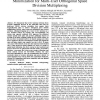Free Online Productivity Tools
i2Speak
i2Symbol
i2OCR
iTex2Img
iWeb2Print
iWeb2Shot
i2Type
iPdf2Split
iPdf2Merge
i2Bopomofo
i2Arabic
i2Style
i2Image
i2PDF
iLatex2Rtf
Sci2ools
GLOBECOM
2006
IEEE
2006
IEEE
Sum Rate Maximization and Transmit Power Minimization for Multi-User Orthogonal Space Division Multiplexing
—We demonstrate that receive antenna selection (RAS) provides significant increase in the achievable sum rates for multi-user MIMO wireless downlinks that employ block diagonalization (BD) to achieve orthogonal space division multiplexing (OSDM), where each user terminal has one or more antennas. Although dropping one or more receive antennas at a user terminal reduces its capacity and correspondingly, the system sum capacity, judicious RAS improves the projected channel spatial mode gains and provides additional degrees of freedom to all other terminals within the BD-OSDM context. In this way there is mutual benefit to be shared among users when RAS is applied to all users and numerical results show significant sum rate gains despite sum capacity loss due to RAS. In many cases, users with reduced array sizes also enjoy increased channel rates. When projected virtual channels are used as a means of spatial mode allocation, this RAS concept is also beneficial and may be referred to as...
| Added | 11 Jun 2010 |
| Updated | 11 Jun 2010 |
| Type | Conference |
| Year | 2006 |
| Where | GLOBECOM |
| Authors | Boon Chin Lim, Christian Schlegel, Witold A. Krzymien |
Comments (0)

